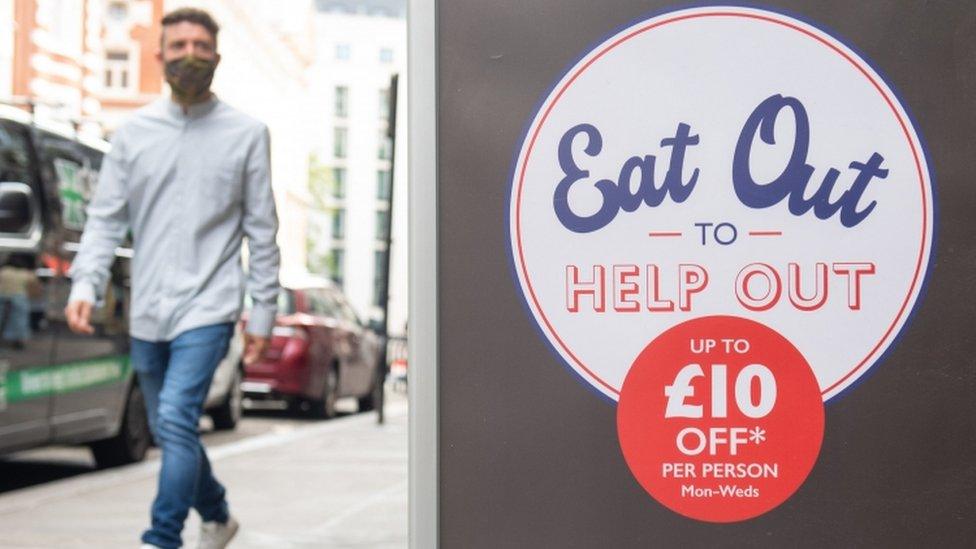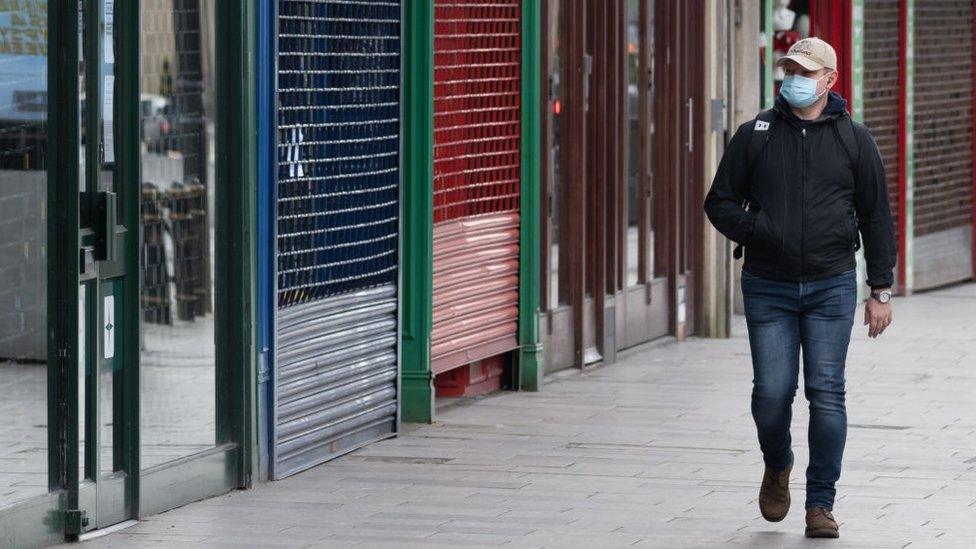Coronavirus: Furlough's final furlong brings job loss fears
- Published

The furlough scheme has been a success but, with six weeks to run, pressure is building for either an extension or new forms of jobs and income support.
The Scottish government has costed an eight-month extension of the scheme and says it could avoid unemployment for more than 61,000 Scots in the first part of next year.
Ministers cite other countries with plans going well beyond the end of October, while think tanks and pressure groups have their own ideas for what will be needed next.

Until last March, furlough was a word for the military and missionaries. Now, it's at the heart of economic policy, in the UK and in other countries with the borrowing power to afford it.
The Coronavirus Job Retention Scheme (CJRS), to give it its Sunday name, can't go on for ever. It seems everyone is agreed on that. But how long should it go on? And if not the current scheme, what could replace it?
By last month, when new entrants to the CJRS were barred, 9.6m UK employees had benefited for at least three weeks since March, paid 80% of normal pay, up to £2,500 per month. Some 1.2m employers had made use of the scheme, at a cost of £35.4bn.
That, depending how you count it, is roughly the entire annual budget for Holyrood.
The furlough scheme is being wound down. Last month, employers had to pay national insurance contributions for furloughed workers. This month they're also paying 10% of pay while the UK government pays 70%. Next month, the ratio changes to 20/60.
And on Halloween, when the scheme ends, the fear is of an unemployment horror show.
On the Ides of September, we're 45 days out from that ghoulish prospect, which is the point at which employers that intend to make more than 100 workers redundant have to state that jobs are at risk, triggering a consultation.
Where 20 to 100 redundancies are planned, the requirement is for 30 days notice.
Spend or tax
The UK Chancellor, Rishi Sunak, has consistently made the case for the scheme to come to an end, or at least to emphasise that it can't go on forever. This week, he was emphasising how many people have gone back to work already - many of them, enthusiastically.
But in a BBC interview, he said two significant things about the scheme; that it can't protect jobs that aren't going to return, and that he's looking for innovative and effective new ways to protect and create jobs.
So he's drawing a distinction between those jobs that are bound to go (some would disappear in a normal year) and those that will return once normal service in the economy is resumed.
It was at least as significant that he did not say two things.
Firstly, that the scheme will entirely and completely end at Halloween - he's left some room for manoeuvre.
Secondly, he didn't say his attention is turning to the deficit, and getting public spending under control.

Chancellor Rishi Sunak faces some difficult decisions with estimates that coronavirus could cost the economy up to £391bn this year
Two weeks ago, questions of tax increases or spending cuts were to the fore, as kites were flown on future Treasury policy. But for now, Mr Sunak continues to spend and focus on economic recovery, while a second wave of infection brings the risk of dislodging that recovery from its moorings.
His jobs plan, announced in July, featured the Eat Out to Help Out scheme - then, something of a gimmick, now something of a success. In Scotland during August, 8,533 eateries claimed for 6.3m meals, at an average £6.10 per head. Subsiding people's nosh worked so well that it took nearly half a percentage point off consumer inflation.
The other measures include the KickStart scheme, offering six months work experience for young people, but with awkward conditions attached that make it hard for smaller employers to access the funds. For England, there were also apprentice funds and some to boost spending on energy efficient home improvements.
And to keep the furlough spirit going past Christmas, the Chancellor has a £1,000 bonus per worker who has been furloughed during 2020, and then constantly employed until 31 January.
That's not seen as being very smart or targeted, in that it will be expensive, at potentially £9.6bn, it's rarely going to provide enough incentive to keep someone employed for three months, and it rewards many employers who would have kept people on their payroll anyway.
Labour market behaviour
The Scottish government, which wants furlough extended, has dug into data from the Office for National Statistics, and says that 57% of the workforce in arts, entertainment and recreation were still furloughed in mid-August to 6 September, and 34% of those in hospitality. Other sectors are less vulnerable, with less than 14%.
The government's number crunchers went to work on a furlough extension and came up with a costing.
It starts from the estimate of 217,000 Scots estimated to be furloughed this month, falling to 102,000 by the end of next month.
Hand out 80% of pay, assume they pay tax on that, and deduct the savings from not having to give them unemployment benefit. That comes to £850m by the end of next June.

More than six million meals bought in Scotland in August were subsidised by the Eat Out to Help Out scheme
With further working assumptions about the behaviour of the labour market, the Scottish government says that should result in employment being 50,000 higher, and bring unemployment 61,000 below the level it would otherwise reach by early next year - reaching 7% instead of 9.5%. It says that gap would be sustained at least until the end of 2023.
For comparison, the number who said they were seeking work in the most recent count, for May to July, was 128,000, or 4.6% of the workforce.
With the simplest calculation of all, scaling that up to the UK's population brings the bill to a neat £10bn. And if you've already blown £190bn on tackling the coronavirus crisis, it can be made to look like a bargain.
Targeted support
The case is backed up with reference to other countries that are continuing their furlough schemes to the end of the year, and some well beyond it.
But that can be misleading.
Every country has a different form of wage subsidy. Most target it at companies that have to prove their loss of revenue, with varying levels of reduction being set as a threshold for support. So far, no comparable country is both as indiscriminate in its distribution and as generous as the UK's 80% of pay.
Most other governments are trying to target their spending more effectively to where it's needed or can be most effective.
One option for the UK is to target sectors. That's already the case with a business rates holiday for retail, hospitality, tourism and, in Scotland, aviation. Adding to grants and government-backed loans for firms, the targeting has honed in on arts and culture, with £1.5bn more at UK level bringing nearly £100m to Holyrood.

The dramatic downturn in the economy has seen a number of suggestions for ways the UK government can try and revive GDP
Could the furlough scheme work for sectors that remain highly constrained by social distancing and quarantine rules such as hospitality and tourism?
The Treasury is unconvinced. The supply chain for companies in these sectors is not so clear cut.
Financial hardship
Other ideas are being floated by think tanks and pressure groups.
The Institute of Employment Studies suggests targeted wage support and also a reduction in employers' payroll tax: stepping up quality training for those at risk of redundancy: and improved enforcement of employment and redundancy rights.
The Joseph Rowntree Foundation says a temporary, targeted jobs support scheme should favour those most at risk of redundancy. With its expertise in studying the effects of poverty, it says 40% of those on minimum wage face a high or very high risk of redundancy, but that is true of only 1% of those earning £41,500. And those lower wage people are more likely to be young, women, disabled, and from Pakistani or Bangladeshi backgrounds. It also notes that the risk of Covid-19 leading to job losses is higher in more deprived areas, so it wants to see the UK government use funds to push further on its aim of 'levelling up' those poorer areas.
The Institute for Fiscal Studies found that furlough and the self-employed income support scheme worked well for those who received them, but up to 2m self-employed people did not qualify, and for those who had to turn to Universal Credit, the five-week delay in payment led to financial hardship and unpaid bills. It concludes that has to be addressed with any return to income support for workers.
Food banks
At the Resolution Foundation, with a focus on the labour market and living standards, its experts emphasise that the challenge to UK jobs is sectoral and not regional, so any job support should address that.They say policy should be aimed at preventing redundancies in hard-hit sectors, to generate new jobs elsewhere in the economy and to give unemployed people support to take up those jobs. This should involve a wage subsidy or employer National Insurance contributions cut in the hard-hit sectors, and job creation via direct public investment in social care and retrofitting of homes to make them more energy efficient.
National Insurance cuts have the benefit of not only making it easier to retain people in employment, but also to recruit people out of unemployment.
The Resolution Foundation has a call for support to be sustained also for those dependent on Universal Credit. It was little noticed while other job support schemes were introduced, but such families gained £1,000 to £2,000 in additional funds from the Treasury in spring. There's a decision to be made on whether that gets continued with the start of next financial year, when many more people are expected to be dependent on the benefit.
If not, the Trussell Trust has been warned this week, through analysis it commissioned by the National Institute of Economic and Social Research, that demand for food banks will rise 150% by next year, boosted particularly by self-employed people and the ranks of the newly unemployed.
Finally, the Fraser of Allander Institute in Glasgow highlights the impact not only of people losing jobs, but of workers losing hours of work and income.
David Eiser questions whether the end of furlough will mean people returning to their previous jobs, and in which sectors, how many lose hours, how easy it is to shift to new jobs, and how many will become unemployed or economically 'inactive', no longer looking for work.
The answers, he concludes, will have an impact on inequality, social security, education and training.
- Published26 August 2020

- Published15 September 2020

- Published15 September 2020

- Published15 September 2020

- Published30 September 2021

